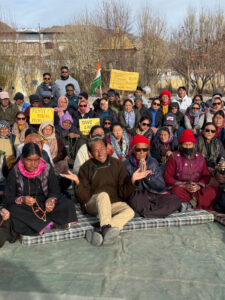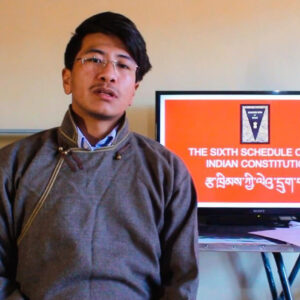by Anna Violante

The ‘Pashmina March’, as it was called, was to have started last Sunday, 7 April. Following in the footsteps of Mahatma Gandhi’s ‘Salt March’ of March-April 1930, the long trek would have been a non-violent protest taking thousands of demonstrators from Leh to the Chinese border, where nomadic tribes and their precious goat herds (their fur is used to make cashmere and pashmina) are being sacrificed in the name of development and security.
Two days before the start of the march, the administration of the Union Territory of Ladakh imposed prohibitory orders under Section 144 of the Criminal Code against gatherings and downgraded internet connectivity from 4 and 5G to 2G, while imposing “restrictions on movement by turning Leh into a war-like zone with armed barricades on all roads leading to Leh city. Under these circumstances, the chances of violence are very high, which could then be used to label this peaceful movement as anti-national.” Sonam Wangchuk, the renowned education reformist and climate activist who is leading the protest with the Apex Body Association, publicly said when they officially called off the march on Saturday 6 April.

The Atlas of Wars interview with Jigmet Paljor, coordinator of the Apex Body, dates back to last Wednesday, 3 April, when the government crackdown had not yet begun.
What is the Apex Body and what is the aim of the protest?
The Apex Body is an amalgamation of religious, social and political groups for the demands of Ladakh. It is not affiliated with any political party and was formed in Leh district (Leh is the largest town and the joint capital of Ladakh along with Kargil, ed). Our struggle is based on 4 inalienable points: 1) Statehood, 2) Special Status under the Sixth Schedule of the Constitution, 3) Additional Parliamentary Seats and 4) Exclusive Public Service Commission for recruitment. Let me explain them more clearly. Ladakh was part of the state of Jammu and Kashmir and in 1979, it was divided into two districts: Leh and Kargil, the first being predominantly Buddhist and the second Muslim. In 2019, President Narendra Modi’s government split Jammu and Kashmir on one side and Ladakh on the other into two union territories, removing their statehood status. Since then, Ladakh has been governed by a Delhi-appointed governor who implements all central government policies. Given that 97 per cent of the population is tribal, tribal status under the Sixth Schedule of the Indian Constitution would allow the formation of autonomous administrative divisions with some legislative, judicial and administrative autonomy. Laws on important things like land, forests, water and mining are currently made by the parliament in Delhi, which doesn’t know our territory and the fragility of our ecosystem. We also want fair representation in the federal government and don’t want people from the mainland occupying all the public offices. So far we’ve had ten meetings with Home Minister Amit Shah and other authorities, but all our demands have been rejected. That’s why we have started fasting in protest and Muslims from Kargil will join us as soon as they finish Ramadan. We share all issues. All decisions are made jointly by the Apex Body and the Kargil Democratic Alliance.
What are your main concerns?
The government has already designated a huge area for solar power plants, but there’s a lot more territory to explore and exploit. It will be exploited by private companies whose only aim is to make money. The damage is in progress. The government is already planning big hotels for mass tourism, mines and industries… Once these things are there, it will be impossible to go back. The Ladakh region is so unique in terms of geography, climate, culture and ethnicity. It is so different from the rest of India. We are already affected by global climate change, it is really visible here. Our glaciers are melting fast and the survival of our entire population depends on the water we get from the glaciers. We live in a 3500 to 5000-metre-high desert, we have no monsoon and no rain. In many villages, we are facing draughts. People already have to leave their villages and give up farming. We don’t want to be destroyed in the name of development.
What about the ‘Pashmina March’ or ‘Gandhi March’ as you call it?
We plan to walk to the Changthang region, famous for its cashmere and pashmina. Nomadic people depend on very specific land to graze their goats. With no defined borders, the Chinese have been grabbing it for many years, while mainland India has taken it to build military bases to fight the Chinese. There’s also a huge solar energy project that won’t benefit us and will mean new fencing of grazing land. All the power generated by the upcoming solar project will go directly to the Indian mainland because our requirements are already in place. The high consumption in Ladakh is around 70 megawatts per hour. The 13 gigawatts they want to generate is mainly for industrial purposes.
Why Gandhi and how is your protest organised?
Gandhi’s protests were famous. We Ladakhis are a very innocent and peaceful community, so our culture inspired us to follow the non-violent way. It is the safest and most powerful way to present our demands to the world or the Indian government. We began our protest with a fast. In February, in the main square of Leh (3500m) at -15 degrees Celsius. Our leader, Sonam Wangchuk, fasted for 21 days, with people taking turns to join him. When he stopped, about 300 hundred Buddhist and Muslim women began their hunger strike, replaced yesterday by young people. It will be the turn of the monks, and then perhaps Sonam Wangchuk will start again, followed by people from Kargil and other sectors of civil society. We are determined to continue until the government listens to our demands and finds an acceptable solution. India is a democracy, after all, or is it not?
On the cover photo, women of Leh during their 10-day fast (photo by Apex Body)
























